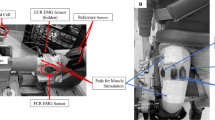Summary
Bye movements in 3 patients with a complete paralysis of one of the horizontal eye muscles were studied. In these cases, all horizontal movements of the affected eye were due to the opposing, well functioning muscle. No reciprocal innervation changes had to be taken into account in the paralysed muscle. The eye with the paralysed muscle, i. e. the “bad“ eye, was occluded, and the “good“ eye had to perform horizontal saccades which were initiated from various positions in the horizontal plane and were aimed towards the working direction of the well functioning muscle of the “bad“ eye. The response of the “bad“ eye always began with a phasic jerk. After this jerk the eye receded to a new position with an exponential time course. The difference between the previous and the new steady position was regarded as the tonic response. The jerks of the “bad“ eye were only a little short of the saccades of the “good“ eye, regardless of the position of the eyes at saccade onset. The amount of change in the tonic position largely depended on the sector of the “field of gaze“ in which the saccade of the “good“ eye was performed. In the “off“-field of the “bad“ eye's working muscle, the tonic response was negligible, in the “on“-field the tonic responce reached nearly normal amplitude. These results fit nicely to Collin's measurements of “in situ“ tendon forces in freely moving eyes“ and allow some inferences to be drawn as to the division of labour in the agonist and antagonist. The main task of the agonist in its “off“-field is to accelerate the globe during saccades. The ensuing new position is held predominantly by relaxation of the antagonist. In its “on“-field, the agonist is important for both, holding eccentric eye position as well as acceleration during saccades.
Zusammenfassung
Die Augenbewegungen von 3 Patienten mit totaler Lähmung eines R. internus oder eines R. externus wurden elektronystagmographisch untersucht. Das freibewegliche Auge führte Blickzielbewegungen im horizontalen Meridian aus. Am Partnerauge (mit dem gelähmten Muskel) zeigte sich dabei folgendes: Bei Sakkaden in der Wirkungsrichtung des gesunden Muskels ruckte das Auge mit einer Amplitude, die etwa dem geforderten Blicksprung entsprach. Nach dem Ruck sank das Auge aber wieder völlig oder teilweise in die Ausgangsstellung zurück. Die verbleibende Stellungsänderung war umso größer, je weiter die Sakkade im Wirkungsfeld des gesunden Muskels ausgeführt wurde. — Aufgrund der Befunde kann geschlossen werden, daß ein normaler Augenmuskel zur Beschleunigung des Bulbus im gesamten Blickfeld gebraucht wird. Zum Halten des Bulbus wird der Muskel dagegen nur dann benötigt, wenn der Bulbus in der Blickfeldhälfte steht, die seiner Wirkungsrichtung entspricht.
Similar content being viewed by others
Literatur
Collins, C. C.: Peripheral eye movement control. In: Symposium über „Basic Mechanisms of Ocular Motility and their Clinical Implications“. Stockholm, 1974 (in Vorbereitung)
François, J., Derouck, A.: Etude électro-oculographique des paralysies oculaires. Acta ophthal. (Kbh.) 33, 523–550 (1955)
Keller, E. L., Robinson, D. A.: Absence of a stretch reflex in the extraocular muscles of the monkey. J. Neurophysiol. 34, 908–919 (1971)
Metz, H., Scott, A., O'Meara, D. M.: Ocular saccades in lateral rectus palsy. Arch. Ophthal. 84, 453–460 (1970)
O'Meara, D.M., Metz, H.S., Steward, H.L., Scott, A.B.: Eye movement patterns in stabismus. Invest. Ophthal. 8, 651 (1969)
Robinson, D. A.: The mechanics of human saccadic eye movement. J. Physiol. (Lond.) 174, 245–264 (1964)
Scott, A. B.: Extraocular muscle forces in strabismus. In: The control of eye movements. P. Bach-Y-Rita, C. C. Collins, J. E. Hyde, eds., New York-London: Academic Press, 1971
Author information
Authors and Affiliations
Additional information
Mit Unterstützung der Deutsehen Forschungsgemeinschaft SFB 70, B4.
Rights and permissions
About this article
Cite this article
Theopold, H., Kommerell, G. Phasische und tonische Funktion der Augenmuskeln. Albrecht von Graefes Arch. Klin. Ophthalmol. 192, 247–254 (1974). https://doi.org/10.1007/BF00416870
Received:
Issue Date:
DOI: https://doi.org/10.1007/BF00416870




